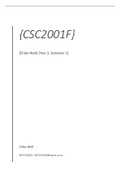Exam (elaborations)
ATI MATERNAL NEWBORN PROCTORED EXAM ATI MATERNAL NEWBORN PROCTORED EXAM ATI MATERNAL NEWBORN PROCTORED EXAM
- Course
- Institution
ATI MATERNAL NEWBORN PROCTORED EXAM ATI MATERNAL NEWBORN PROCTORED EXAM ATI MATERNAL NEWBORN PROCTORED EXAM ATI MATERNAL NEWBORN PROCTORED EXAM ATI MATERNAL NEWBORN PROCTORED EXAM
[Show more]












